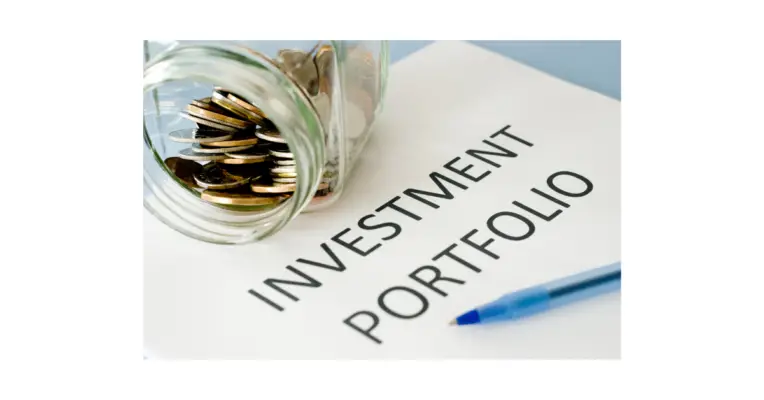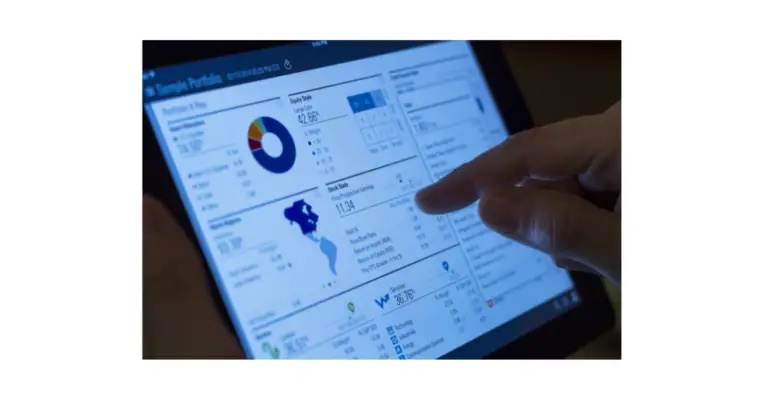Portfolio risk management is a critical part of the investment process.Portfolio managers are responsible for investing and diversifying their clients’ assets while reducing risk and maximizing investment return.
They also manage liquidity risks that may arise from changes in market conditions or outflows of client funds. Their decisions have significant impacts on financial markets worldwide because so many people rely on them to help them manage their investments. Investors need to understand what portfolio management involves and how it affects their portfolios.
In this post, we’ll take a closer look at portfolio risk management: how do you measure and manage investment portfolios? We will discuss some of the key concepts involved with measuring and managing asset allocation and some of the different types of risks that can affect portfolios.
Portfolio risk management definition
Portfolio risk management is the process of identifying, assessing, and managing risks associated with a portfolio of investments. The goal of portfolio risk management is to protect the investors’ principal and to maximize the return on their investment. Risk is defined as the potential for loss or reduced return on investment.
There are three types of risk that investors need to be aware of: market risk, credit risk, and interest rate risk. Market risk is the chance that the price of a security will decline due to changes in the overall market conditions. Credit risk is the chance that a security will not be repaid when it matures. Interest rate risk is the chance that interest.
Since all information of portfolios, cloud and internet is the storage. There can be instances of cyber security threats that may impact the porfolio database. Increasing reputational damage for example in crypto trading sphere where instances of data breaches have occured .
One of the most important aspects of portfolio management is measuring and managing risk. Risk can be defined as the potential for losses in an investment portfolio. It’s essential to measure and understand the various types of risks that can affect your portfolio so that you can take steps to mitigate them. There are many different types of risk that you need to be aware of, including:
- Market risk: This is the risk that the value of your investments will decline due to changes in market conditions. It can be caused by economic recessions, political instability, changes in interest rates, or inflation. Market risk perspective is the inclusion of overall portfolio risk responses.
- Liquidity risk: This is the risk that you will not be able to sell your investments when you need to. It can be caused by a lack of buyers in the market or illiquid investments that are difficult to sell.
- Credit risk: This is the risk that the issuer of a bond or other investment will not repay you what you are owed. It can be caused by the company going bankrupt or by a decline in the issuer’s creditworthiness.
- Interest rate risk: This is the risk that interest rates will rise and cause the value of your investments to decline. It can be caused by economic factors such as inflation or changes in government policy.
- Political risk: This is the risk that political instability or changes in government policy will affect your investments. It can be caused by coups, wars, or changes in tax or regulatory policy.
- Behavioral risk: This is the risk that investors will make irrational decisions that could lead to losses in their portfolios.
Asset allocation, effective portfolio designs, and dynamic managing are beneficial to deal with volatile market conditions, but the key risk indicators has been gaining greater attention in recent weeks. The economy sank, low yields, and the stock markets fell several notches. The investment industry is trying different methods to deal with the risks.
The discussions usually revolve around equities in the stock market— a riskier asset class with the largest allocation in many portfolios. It appears to be well understood that many banks are looking to decrease their losses by allocating to a less liquid return source.
Portfolio risk management helps organizations safeguard portfolio investments and manage risk levels in a portfolio. Those with specialized portfolio managers can begin portfolio risk management when implementing the intake and prioritization process. The COVID19 crisis is one recent example that shows the value of a portfolio risk management system. Overall portfolio risk is evaluated and managed by incorporating risk assessments, scenario analyses, and stress tests by project managers.
A portfolio is a collection of investments, such as stocks, bonds, and real estate. It is essential to safeguard using a portfolio risk management system. This system helps organizations manage the risk levels in their portfolios.
The market always weighs the risk with profit. Investors get rewards for taking risks — however, this risk is controlled. Depending on the portfolio, risk must be rated as appropriate. Secondly, portfolio risk must be calculated at this risk level. Knowledge and management of investment risks are crucial for the growth and preservation of capital.
Portfolio management and asset allocation on portfolio risks are essential risk management methods. Many investors mistakenly believe that they can eliminate all risks, but this is impossible.

What is Portfolio Risk Management?
In portfolio risk management, standardized processes are used for identifying, assessing, measuring, and managing risk in an asset portfolio. These actions follow the same procedures as in traditional risk management projects.
Compared to project risk management, which is primarily focused on events affecting projects, portfolio risk management focuses on events impacting strategic targets. Portfolio risks are far broader than program risk management and require a high-level leadership role.
Portfolio risk management is essential in safeguarding portfolio values and empowers portfolio governance teams to monitor portfolio risks effectively. The ability to effectively manage risks increases the portfolio value and overall portfolio value.
Companies must determine risk tolerance and measure this to improve portfolio management. Other firms and industries have fewer risks than others, i.e., retail banks and financial institutions.
Systemic risks are risks that can affect an entire industry or economy. Stock markets, for example, are vulnerable to systemic risk. The 2008 financial crisis was a prime example of systemic risk.
Geopolitical risks are associated with political instability in certain parts of the world. For example, the current Syrian refugee crisis is a geopolitical risk. A recent study by Boston Consulting Group (BCG) on global risks found that geopolitical risk is the number one risk to global economic growth.

Managing Portfolio Risks
A common-sense approach for managing portfolio risk involves managing certain risk levels. They pose serious threats that may affect achieving strategic goals. Portfolio risks are designed to reduce the likelihood of positive portfolios as other risks impact them.
It happens mainly during the protection of portfolio values phases. Portfolio project managers have the ultimate responsibility of portfolio management. Portfolio risk follow the usual risk management process from identification to monitoring.
One of the best ways to protect a portfolio from harm is to diversify its holdings. However, while diversification can help reduce the impact of some risks, it cannot protect against all potential dangers. In addition, other risk-mitigation techniques can be employed, such as hedging and insurance.
Hedging is the process of taking out insurance against losses on specific investments. For example, if an investor owns a stock they believe is vulnerable to a decline in value, they might purchase a put option on that stock. Risk management integration of portfolio risks is important.
A put option gives the investor the right to sell the stock at a pre-determined price, known as the strike price. If the stock declines in value below the strike price, the investor can exercise the option and sell the stock at a higher price. It will help to offset any losses that may have been incurred.
Insurance is another way to protect a portfolio from potential losses. When an investor buys insurance, they essentially transfer the risk of a potential loss to an insurance company. If the investment declines in value, the insurance company will reimburse the investor for their losses. It can be a helpful way to protect against significant losses, which may be difficult to recover.

What are the 3 Types of Portfolio Management?
Active portfolio management.
Active portfolio management is the most hands-on type of portfolio management. It involves making regular decisions about what stocks or assets to buy or sell to achieve the desired return on investment.
Advantage of Active portfolio management
- It offers greater control over investment choices and the ability to react quickly to market changes.
- An Increased opportunity for higher returns, as active management can exploit inefficiencies in the market.
- It offers a more remarkable ability to protect capital during market volatility or downturns.
Passive portfolio management.
Passive portfolio management is a more hands-off approach, also known as buy and hold investing. Under this method, an investor chooses a set of stocks or assets and leaves them alone to grow over time.
Advantages of passive portfolio management
- It offers less time spent on management and research.
- Automatically takes advantage of market fluctuations.
- No need to stay up to date with news and events
Discretionary Portfolio management.
Discretionary portfolio management is a combination of the two previous methods. Using this approach, an investor makes periodic decisions about which stocks or assets to buy or sell and leaves some investments alone to grow over time.
Advantages of discretionary portfolio management
- It offers increased flexibility and control over the investment process.
- It affords the ability to tailor the investment portfolio to specific goals and risk tolerance.
- It creates more opportunities to exploit market inefficiencies.
- It brings out a remarkable ability to react to changing market conditions.
- It offers More hands-on management results in a better understanding of individual investments.
What Are The Two Types of Portfolio risk?
Loss of capital
Loss of capital is one type of portfolio risk. It is the risk that you will lose some or all of your original investment in a security or portfolio. It can be caused by a decline in the security price or by the security’s issuer going bankrupt.
The decline of the security price is the most common form of loss of capital. It can be caused by several factors, such as a general decline in the stock market or specific events that affect the particular security. For example, if a company announces that it will have to file for bankruptcy, the price of its shares is likely to fall sharply.
The other form of loss of capital is when the security issuer goes bankrupt. It can happen if the company cannot pay its debts or if another company takes it over. In either case, the security holders will likely lose some or all of their investment.
Sovereign risks
Sovereign risk is the risk that a particular country will not repay its debt. It can be caused by political instability, economic instability, or natural disasters. Sovereign risk is a portfolio risk that is usually taken into account when investing in foreign countries.
Investing in such countries can be risky, as the default of a single country can have a ripple effect throughout the global economy.
Sovereign risks are also a concern for international organizations like the IMF and World Bank. These organizations often provide loans to countries in need, but they must weigh the risk of not being repaid against the potential benefits of helping a country in crisis.
Sovereign risks are also a concern for individual investors. When investing in foreign countries, it is vital to be aware of the political and economic conditions of the country in question. A country with a history of political instability or economic turmoil is likely to have a higher sovereign risk than a stable and prosperous one.
Purchasing power or “inflation risk.”
Inflation risk can be a risk to a portfolio in two ways: its effects on the purchasing power of investments and its effects on the value of liabilities. Also falls in currency risk portfolio level risks.
When inflation rises, the purchasing power of money falls. It means that people need more money to buy the same goods and services. For example, if the inflation rate is 2%, prices will rise by 2% each year. To keep up with rising prices, people need to invest their money in assets that will increase value at a higher rate than inflation.
In addition to affecting the purchasing power of investments, inflation can also affect the value of liabilities. A liability is an obligation to pay someone else money in the future. For example, a bond is a type of liability. When inflation rises, the value of a bond falls. It means that investors will get back less money when the bond matures than they paid for it.
How is Risk Measured in a Portfolio?
There are various ways of measuring portfolio risk. They include:-
Beta – measure a portfolio’s volatility in comparison with benchmark indexes. Beta is an analytical measure used by CAPM that calculates risks by using return to sell assets at a higher cost. … A beta above 1 signifies greater portfolio volatility, while a beta less than 1 indicates a more stable portfolio level. It informs portfolio level risks depending on modern portfolio theory.
R-squared – measures the percentage of a portfolio’s money market funds movements that movements in a benchmark index can explain. A higher R-squared value indicates that a portfolio is more closely tied to its benchmark index.
Alpha – an indication of how much a portfolio outperforms or underperforms the market. Positive Alpha means the portfolio has outperformed the market, while negative Alpha means the portfolio has underperformed.
Sharpe Ratio – It is a measure of risk-adjusted return. The Sharpe Ratio calculates how much return is earned per unit of risk. A higher Sharpe Ratio indicates better risk-adjusted performance.
Sortino Ratio – It is a variation of the Sharpe Ratio that penalizes downside volatility instead of standard deviation. The Sortino Ratio is used to measure the risk-adjusted return of portfolios with different levels of downside risk.
Treynor Ratio – similar to the Sharpe Ratio, but uses beta to measure risk. The Treynor Ratio evaluates the excess return on a portfolio over and above the risk-free rate, divided by the portfolio’s beta.
Jensen’s Alpha – similar to Alpha but adjusts for the amount of risk in a portfolio. Jensen’s Alpha measures how much a portfolio manager has added value (or decreased value) compared to a passive investment strategy.
It is crucial to understand how risk is measured to make informed investment decisions as an investor. By understanding the different risk measures, investors can determine which portfolios have the lowest amount of risk for a given level of expected return.
Project Risk Management
One essential part of project risk management is portfolio risk management. Portfolio risk management is the process of assessing and managing the risks associated with a group of projects or a portfolio of projects.
It includes assessing the overall risk of the portfolio or project risk assessment process, as well as the individual risks associated with each project in the portfolio. It also includes taking steps to manage these risks so that they don’t impact the success of the project portfolio management.
Assessing project risks by project managers to determine portfolio level risks of equity markets. Experienced project managers will look at systematic risk and assess project risks for financial instruments.
The project manager will consider project budgets and compare the same with portfolio budgets.
There are several factors that can impact the risk of a portfolio of projects. Some of these include:
- The type of projects in the portfolio, i.e. tactical asset allocation.
- The complexity of the projects in the portfolio.
- The dependencies between the projects in the portfolio.
- The resources are available to manage the projects in the portfolio.
- The time frame for the projects in the portfolio.
There are several steps that can be taken to manage the risk of a portfolio of projects. Some of these steps include:
- Creating a risk management plan for the portfolio.
- Assessing the overall risk of the portfolio.
- Assessing the individual risks associated with each project in the portfolio.
- Developing mitigation plans for high-risk projects.
- Monitoring the risk of the portfolio and taking steps to adjust as needed.
What is Project Portfolio Risk Management?
Portfolio risk management combines processes that determine, assess, and manage portfolio risks. Portfolio Risk Management has a broad scope beyond program and project risk management and requires leadership participation.
Leadership is responsible for approving the portfolio, ensuring that resources are available to manage risk, and setting the tone for risk management. The organization’s culture and risk appetite also play a role in managing portfolio risks.
Management of portfolio risks will inform portfolio risk management plan development and execution. The goal of portfolio risk management is to identify, assess, and prioritize risks so that an organization can make informed decisions about allocating resources to achieve its strategic objectives.
What are Common Types of Project Portfolio Risks?
- External business risks (e.g., economic and political circumstances, political and regulatory change,
- New legal requirements,
- Natural events such as COVID19.
Process of Project Portfolio Risk Management
- The first step in portfolio risk management is to create a risk management plan for the portfolio. This plan will outline how the risks will be assessed and managed.
- The next step is to assess the overall risk of the portfolio. It includes assessing the risks associated with each project in the portfolio and the dependencies between projects.
- Once the risks have been assessed, mitigation plans can be developed for high-risk projects. The plans will help reduce the chance of these risks impacting the project’s success.
- The final step is to monitor the portfolio’s risk and take steps to adjust as needed. It includes adjusting the mitigation plans as needed and re-assessing the portfolio’s risk regularly.
Portfolio Risk Management & Risk Management Plan
Risk management is the identification, assessment, and prioritization of risks followed by developing and implementing appropriate risk response plans. Risk management is essential to the success of any organization, yet it is often overlooked or done haphazardly.
A well-developed risk management plan can help an organization identify potential risks, assess the likelihood and impact of those risks, and develop strategies to mitigate or avoid them.
Portfolio risk management will allow an organization to identify and assess the risks associated with individual investments or project portfolios. It can help an organization decide which investments or projects to pursue and which ones to avoid.
An organization can allocate resources to the most important risks and develop a strategy for dealing with them through a risk management plan. The risk management plan should also include procedures for monitoring and modifying the plan as needed. It will improve portfolio risk management initiatives.
Portfolio Risk Management Plan
An example of portfolio risk management is in the following case:
Megan is always involved with risk management. She maintains a portfolio of 20% reserve. So, the risk in each portfolio can be viewed as minuscule or as large as a portfolio. Each investment is included in the Risk Register, a risk management plan whose goal is to assess and evaluate the potential impact. The most crucial component of this Risk Register is to establish the list of portfolio risks, including market risks, interest rates, and inflation risks.
A portfolio risk management plan is an essential document for all investors. By having a well-thought-out plan, you can protect your investments and make sure they continue to grow.
Portfolio Risk Management Tools
Portfolio risk management tools help investors, and financial professionals understand and manage the risks associated with their portfolios. There are various tools available, each with its strengths and weaknesses.
One popular tool is the variance-covariance matrix, which measures the volatility of individual assets in a portfolio and their correlation. This information can be used to calculate the portfolio’s overall risk and identify strategies that can reduce that risk.
Another standard tool is the stress test, which evaluates how a portfolio would perform under different scenarios, such as a market crash or interest rate hike. It can help investors understand the risks they are taking on and adjust their portfolios as needed.
Various software programs can help investors create and manage their portfolios. These programs can automate the process of constructing and rebalancing portfolios and tracking performance and risk.
No one tool is perfect for all situations, but by understanding the different options available, investors can choose the best tools to meet their needs.
Conclusion
To measure and manage an investment portfolio, you need to understand the different types of risks associated with it. You also need a system for assessing and mitigating those risks. In this article, we’ve looked at four ways to do just that: through diversification, hedging, asset allocation, and using stop losses. The literature follows this on portfolio risk management. Which of these risk management strategies have you found most effective for your portfolio? Let us know in the comments below.

Chris Ekai is a Risk Management expert with over 10 years of experience in the field. He has a Master’s(MSc) degree in Risk Management from University of Portsmouth and is a CPA and Finance professional. He currently works as a Content Manager at Risk Publishing, writing about Enterprise Risk Management, Business Continuity Management and Project Management.

